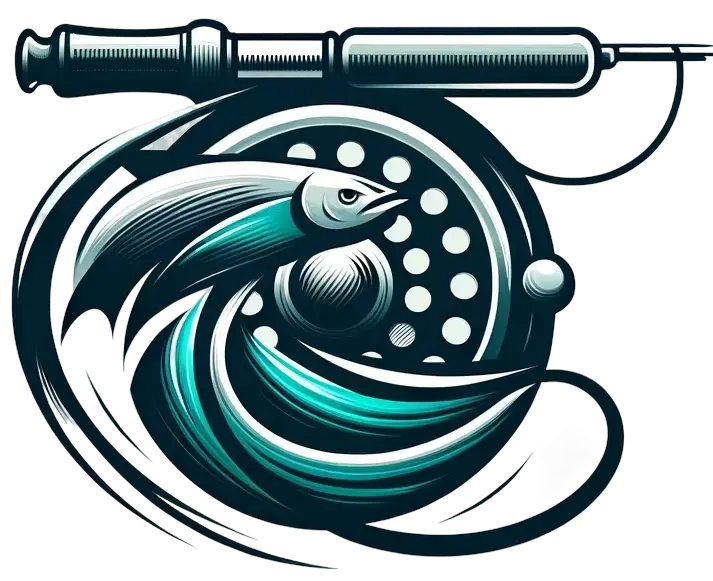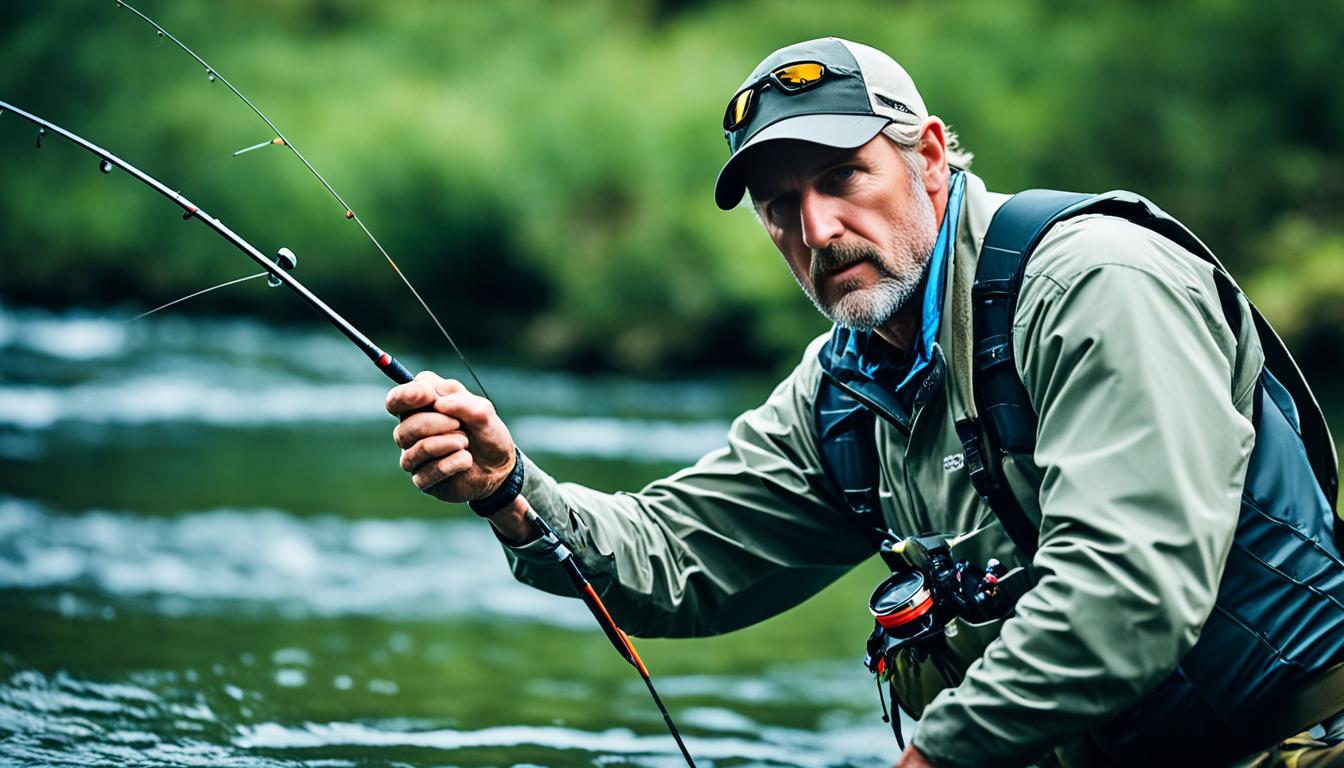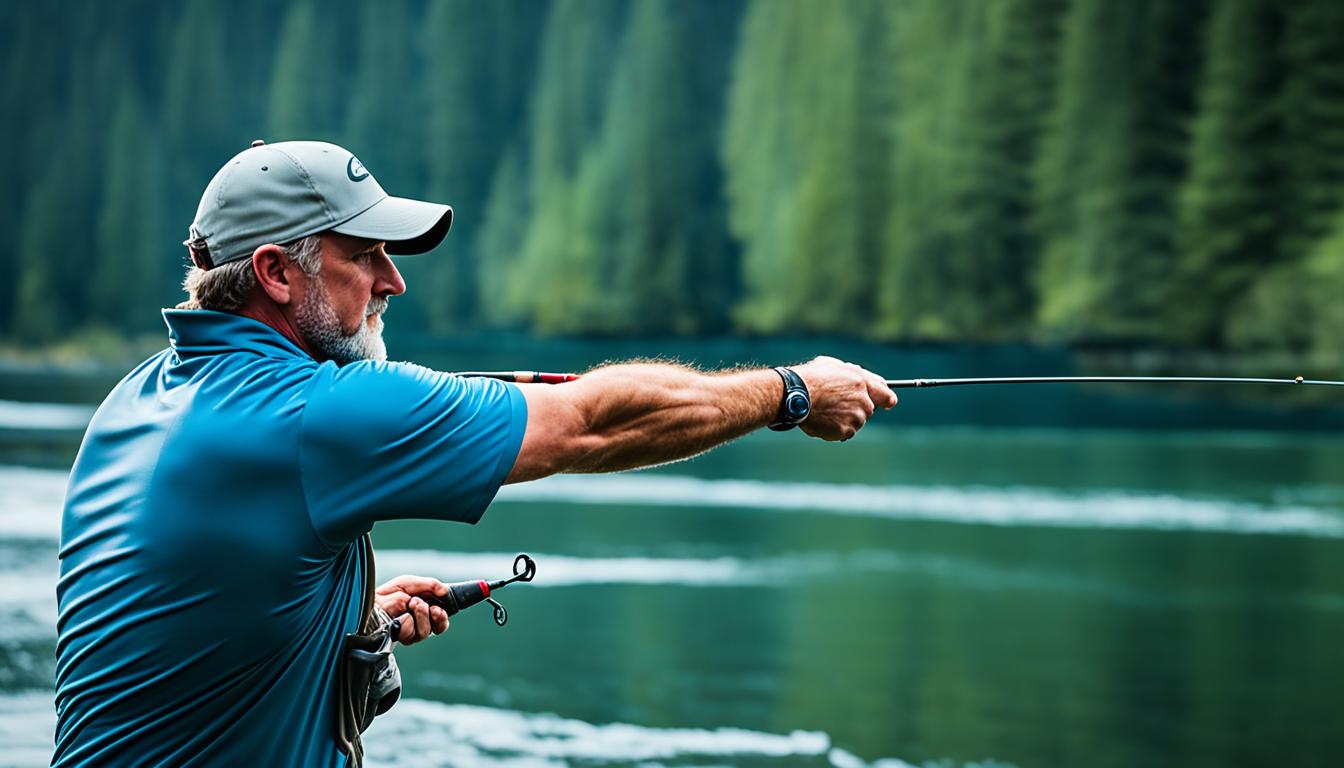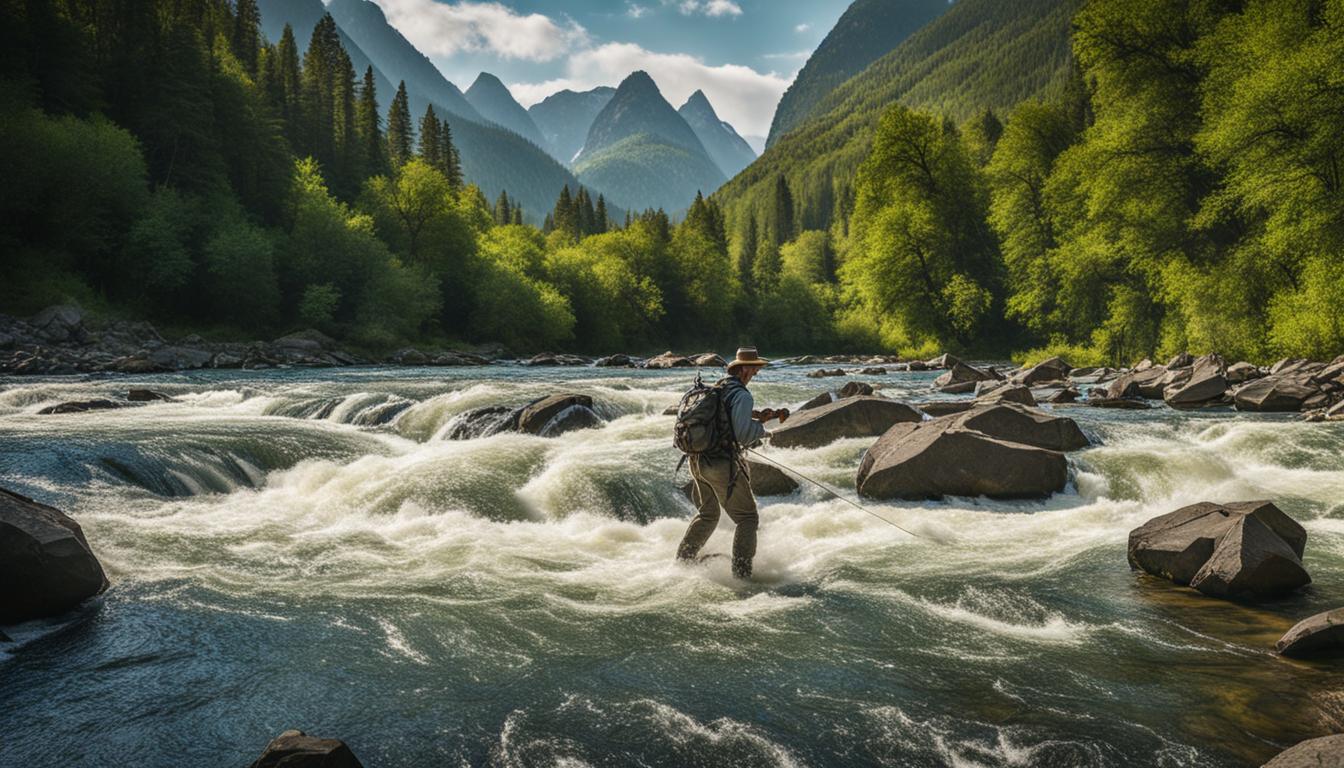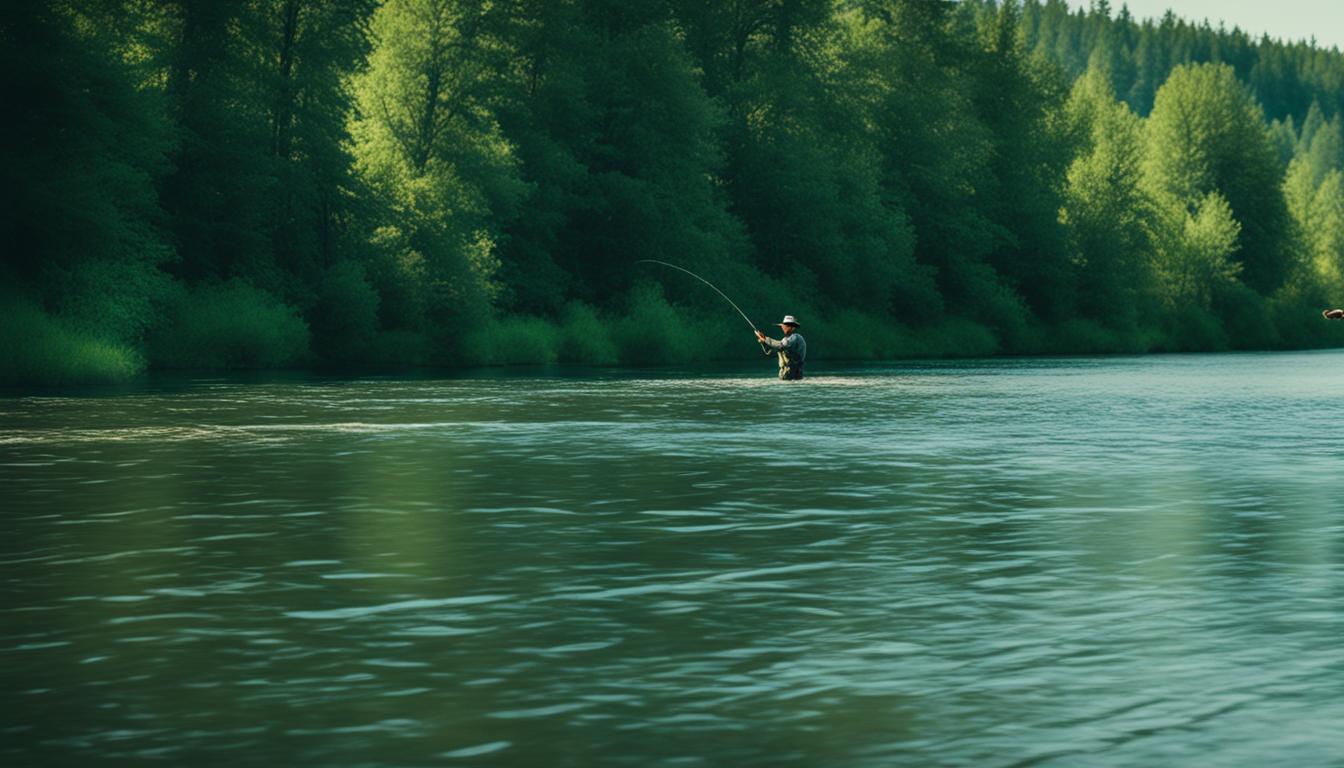Are you ready to take your fly fishing skills to the next level? Then it’s time to master the art of High-Stick Nymphing. This highly effective technique is a game-changer when it comes to catching trout. By keeping your fly rod raised and minimizing the amount of fly line in the water, you’ll achieve a more natural presentation that will entice even the wariest of trout. Whether you’re an experienced nymph angler or just starting out, High-Stick Nymphing techniques will elevate your fly fishing methods and give you a competitive edge on the stream.
Key Takeaways:
- High-Stick Nymphing is a highly effective fly fishing technique for trout.
- By keeping the fly rod raised, you achieve a more natural presentation of the flies.
- High-Stick Nymphing is particularly effective in streams with pocket water and small to medium-sized streams.
- It can be used in combination with strike indicators for better strike detection and depth control.
- Mastering High-Stick Nymphing techniques will greatly enhance your nymph fishing skills.
Now that you understand the basics and the potential of High-Stick Nymphing, let’s dive deeper into the history and nuances of this technique. In the next section, we’ll explore the origins of High-Stick Nymphing and its evolution over time.
The History of High-Stick Nymphing
High-Stick Nymphing has a rich history in fly fishing. It originated from the Brooks method of nymphing, developed by Charlie Brooks on the Upper Madison River.
Before the popularity of strike indicators, fishermen would use the high stick method, keeping the rod tip high and fishing a tight line to control the drift of the fly. This method evolved over time and became known as High-Stick Nymphing.
“When you start fishing across stream and taking fish out of spots you didn’t know were spots, a new facet of nymph fishing shows itself”
According to Brooks, the High-Stick method allowed anglers to effectively fish pocket water and small to medium-sized streams. The technique provides a more natural presentation and increases the chances of enticing strikes from trout.
Over time, strike indicators gained popularity and were used in combination with the high stick method for better strike detection and depth control. This made it easier for anglers to monitor their fly’s position and detect subtle strikes.
In order to master the basics of High-Stick Nymphing and adapt to newer nymph fishing techniques, understanding the history of nymph fishing is essential. By learning from the pioneers like Charlie Brooks, anglers can build a solid foundation and enhance their overall nymph fishing skills.
High-Stick Nymphing vs. Polish Nymphing and Euro-nymphing
When it comes to nymph fishing techniques, there are various methods that anglers can employ to increase their chances of success. Three popular techniques that are often compared are High-Stick Nymphing, Polish Nymphing, and Euro-Nymphing. While they may share some similarities, each technique has its own unique principles and characteristics.
Let’s take a closer look at how these nymphing techniques differ:
High-Stick Nymphing
High-Stick Nymphing is a time-tested technique that predates both Polish Nymphing and Euro-Nymphing. It involves keeping the rod tip high and fishing a tight line to control the drift and presentation of the nymph. By minimizing the amount of fly line in the water, anglers can achieve a more natural presentation. This technique is particularly effective in streams with pocket water and small to medium-sized streams.
Polish Nymphing
Polish Nymphing was introduced by Wladyslaw Trzebunia, a Polish fisherman, and has gained popularity among nymph anglers. This technique utilizes a lower rod position compared to High-Stick Nymphing. It often involves a specific leader setup that enables anglers to maintain a direct line to the nymph and control the depth and drift. Polish Nymphing is known for its versatility and effectiveness in different water conditions.
Euro-Nymphing
Euro-Nymphing is an umbrella term for various European nymph fishing methods that have evolved from Polish Nymphing. This technique typically involves a longer and sensitive fly rod, specialized leader setups, and the use of weighted flies. Euro-Nymphing allows anglers to maintain direct contact with the nymph and detect even the subtlest strikes. It is highly effective in fast-moving or deep water where a tight line is essential for strike detection.
While High-Stick Nymphing, Polish Nymphing, and Euro-Nymphing all fall under the general category of tight line nymphing, it’s important to understand their unique characteristics and techniques. Anglers can experiment with these methods to determine which approach works best for their fishing style and the specific conditions they encounter on the water.
Now, let’s dive deeper into High-Stick Nymphing techniques and learn how to successfully fish using this effective nymphing method.
How to High-Stick Nymph Fish
To successfully high-stick nymph fish, we need to understand and master the techniques involved. One key aspect is maintaining a tight line and controlling the drift of the fly. This is achieved by using a longer rod to control the fly at relatively short distances and keeping the rod tip high throughout the drift.
Observing strike detection is crucial in high-stick nymphing. We should have a good feel for any unnatural movements or direction changes in the line or indicator, which could indicate a strike. Being attentive and responsive to these subtle cues will greatly increase our chances of success.
Depth control is equally important in nymph fishing. We can achieve this by adjusting the weight of our nymphs or modifying the length of our leader. Adding or subtracting weight allows us to control the depth at which our flies are presented, while lengthening or shortening the leader affects the drift and presentation of the nymphs.
Adapting the high-stick nymphing technique to different water conditions and fly patterns is essential for consistent success on the stream. By experimenting with different nymph patterns and adjusting our approach based on the behavior of the fish and the specific conditions we encounter, we can increase our chances of enticing strikes.
“Mastering the art of high-stick nymphing requires a combination of finesse and intuition. By honing our skills in strike detection, depth control, and adaptation, we can elevate our nymph fishing game to a whole new level.”
Fly Patterns for High-Stick Nymphing
When it comes to fly patterns for high-stick nymphing, it’s important to have a variety of nymphs that mimic local insects. Matching the hatch and understanding the prevalent food sources in the stream will greatly increase our chances of fooling the trout. Here are some recommended nymph patterns:
- Pheasant Tail Nymph
- Hare’s Ear Nymph
- Prince Nymph
- Copper John
- Zebra Midge
Recommended High-Stick Nymphing Gear
While high-stick nymphing doesn’t require any special equipment, there are a few gear considerations that can enhance our effectiveness. Here’s what we recommend:
| Item | Recommended |
|---|---|
| Fly Rod Length | 10-11 feet |
| Strike Indicators | Small, sensitive indicators |
| Leader Setup | Longer leader with a taper |
Remember, gear and equipment are important, but the real key to success in high-stick nymphing lies in our understanding and application of the techniques involved. Practice, observation, and adaptability are the foundations for mastering this effective nymph fishing method.
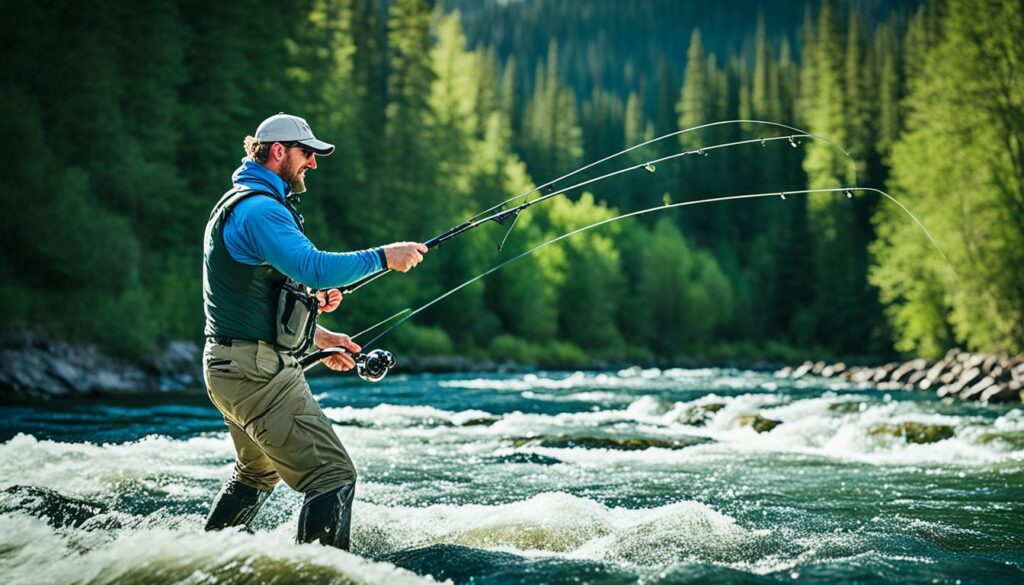
Gear and Equipment for High-Stick Nymphing
High-Stick Nymphing is a versatile technique that doesn’t necessarily require specialized gear. However, there are certain equipment considerations that can significantly enhance your success with this method.
First and foremost, choosing the right fly rod length is crucial for better control and line management. We recommend opting for a fly rod with a length of 10-11 feet. This longer rod will provide you with the necessary leverage to control the fly at relatively short distances and make precise presentations.
Next, strike indicators can be a valuable addition to your High-Stick Nymphing gear. These small, visible markers attached to the leader help improve strike detection by indicating subtle movements that may go unnoticed. By pairing strike indicators with the high-stick technique, you can enhance your ability to detect strikes and react accordingly.
When it comes to fly patterns, having a selection of nymphs that mimic local insects is essential. Match the hatch by selecting nymph patterns that closely resemble the aquatic insects present in the stream you’re fishing. This attention to detail will increase your chances of enticing trout to strike.
Lastly, your leader setup is important for maintaining a tight line and achieving precise control over the drift. The specific leader configuration may vary depending on the water conditions you encounter. Experiment with different setups to find the balance between leader length, tippet diameter, and weight that allows you to maintain a direct connection to the fly and effectively control its depth.
Overall, while High-Stick Nymphing gear doesn’t need to be extravagant, investing in the right equipment can significantly enhance your success on the water. Choose a fly rod with the optimal length, utilize strike indicators for improved strike detection, select nymph patterns that mimic local insects, and fine-tune your leader setup to achieve optimal drift control.
| Recommended Gear for High-Stick Nymphing | |
|---|---|
| Fly rod length | 10-11 feet |
| Strike indicators | For improved strike detection |
| Nymph patterns | Selection of patterns mimicking local insects |
| Leader setup | Customize for tight line and precise drift control |
Conclusion
High-Stick Nymphing is a highly effective technique for catching trout and has a rich history in fly fishing. By understanding the principles and techniques involved, we can master this method and greatly increase our success on the stream.
Combining High-Stick Nymphing with strike indicators enhances our ability to detect strikes and control the depth of our nymph presentation. Adapting the technique to different water conditions and fly patterns allows us to consistently land more trout.
To fully enjoy the benefits of High-Stick Nymphing, it is important to have the right gear and equipment. A fly rod with a length of 10-11 feet provides better control and line management, while a selection of nymph patterns that mimic local insects increases our chances of enticing trout. The leader setup should allow for a tight line and precise control of the drift.
Whether we are seasoned anglers or just starting out in the world of fly fishing, High-Stick Nymphing is a technique worth mastering. By honing our skills and investing in the right gear, we can elevate our nymph fishing game and experience the thrill of landing more trout on our lines. So grab your fly rod, tie on a nymph, and get ready to embrace this exciting fly fishing technique. Tight lines!
FAQ
What is High-Stick Nymphing?
High-Stick Nymphing is an effective fly fishing technique that involves minimizing the amount of fly line in the water by keeping the fly rod raised. This allows for a more natural presentation of the flies and is particularly effective in streams with pocket water and small to medium-sized streams.
How did High-Stick Nymphing originate?
High-Stick Nymphing originated from the method called “High Stick” developed by Charlie Brooks, a fly fishing guide and instructor. It evolved from the Brooks method of nymphing on the Upper Madison River and has a rich history in fly fishing.
How does High-Stick Nymphing differ from Polish Nymphing and Euro-nymphing?
High-Stick Nymphing involves keeping the rod tip high and fishing a tight line, while Polish Nymphing and Euro-nymphing utilize a lower rod position and often involve a specific leader setup. High-Stick Nymphing is an older technique with its own unique principles and techniques.
What are the key techniques for successful High-Stick Nymphing?
Key techniques for successful High-Stick Nymphing include maintaining a tight line and controlling the drift of the fly, having a good feel for strike detection, and achieving depth control through weight and leader adjustments.
Is special equipment required for High-Stick Nymphing?
High-Stick Nymphing does not require any special equipment, but a longer fly rod (10-11 feet) is recommended for better control and line management. Strike indicators can also be used in combination with this technique for better strike detection.
